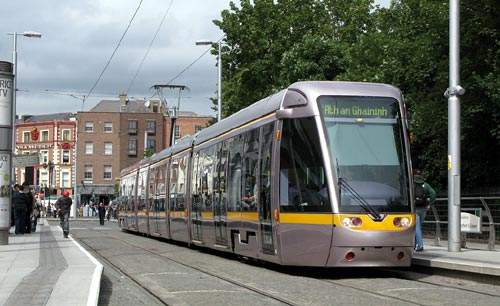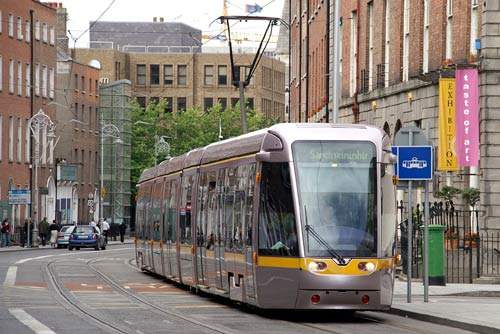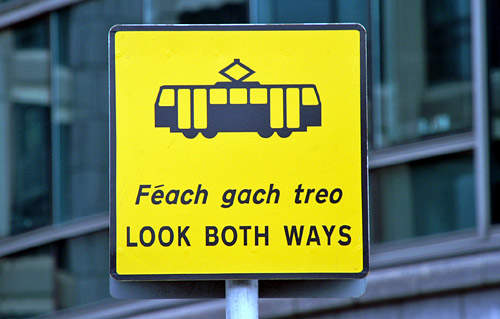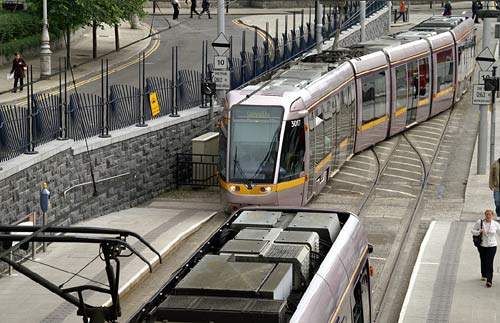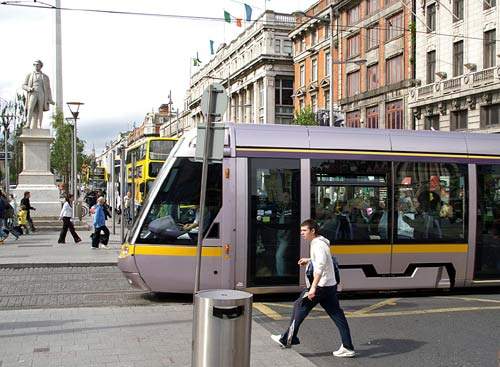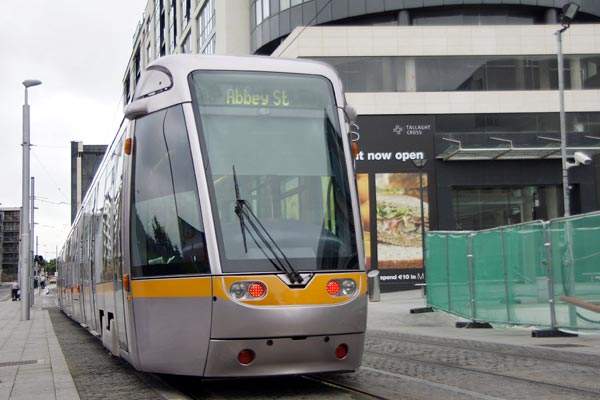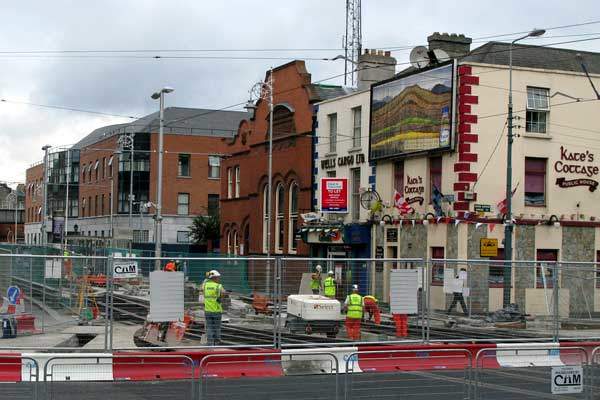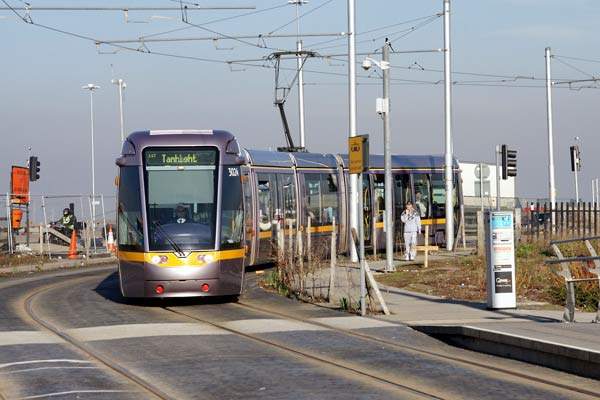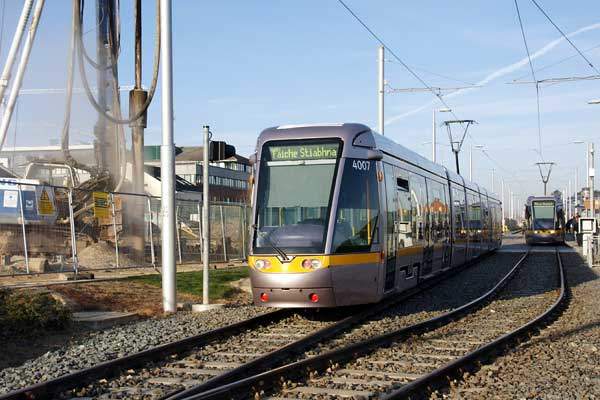Dublin is by far the largest city in Ireland, with over a million inhabitants and forecast by the Irish Central Statistics Office to reach over two million in the metropolitan area by 2021.
With origins in the Dublin Transportation Initiative (DTI) report of April 1994 and initially within the remit of Ireland’s heavy rail operator CIÉ (also IE), the first two Luas (Irish for speed) light rail routes opened in June and September 2004. Luas is due to be greatly expanded over the next decade under the terms of the Irish infrastructure plan, Transport 21, launched in 2005 with an overall initial budget of €34bn.
The Luas project had truly international origins with companies from (among others) Ireland, Italy, France, Australia, the UK and Germany. Construction was contracted to AMB (Ansaldo, MVM and Ballast Needam).
System designers were Sinclair Knight Merz, Halcrow and Roughan & O’Donovan. Mott MacDonald, EPO and Semaly have acted as advisors and assistants to project sponsors, the Railway Procurement Agency (RPA), an arm of the Irish government.
Alstom supplied the trams and Scheidt & Bachmann the automatic fare collection and monitoring system. Selected as the system operator in May 2002, Veolia Transport Ireland (formerly Connex) also acts as manager for the maintenance contracts on the RPA’s behalf.
Infrastructure
The five-year construction programme for the original two routes began in August 1999. Luas has standard European track gauge (1,435mm), different from the heavy rail network’s 1,600mm. Running via IE’s mainline Heuston terminus, the Red Line links the new town development of Tallaght on the south-western outskirts of Dublin with Connolly at the east of the city centre, the other main IE Dublin station. It is one of the few stops on the present system having other than solely ground level access, the Luas line terminus being linked by escalator to Connolly IE station.
Wholly south of the River Liffey, the Green Line is from St Stephen’s Green, adjoining to the city’s Grafton Street retail area, to Sandyford. The line uses part of the formation of the abandoned heavy rail route from Dublin Harcourt Street to Bray.
Mainly a segregated route featuring some substantial structures and engineered to be capable of full metro conversion, approximately 2km runs on-street in a tramway-type operation south from St Stephen’s Green. As built, the Red and Green lines were and remain unconnected, with separate depot and maintenance facilities.
In 2008 the Green Line depot at Sandyford underwent increases to secure storage space in advance of fleet enlargement and the terminus layout re-configured to take account of line extension.
To avoid disruption created by conflict with vehicle traffic and traffic light control, the original Luas routing over the M50 near the Red Cow stop will be removed, replaced by a dedicated alignment built in 2007-08. Park-and-ride facilities are provided at six sites, with revisions during engineering works and more to be added under expansion plans.
Rolling stock
Luas is operated by 40 75% low-floor double-ended Alstom Citadis units, initially configured in 26 30m three-car Red Line formations and 14 40m five-car units for the Green Line. A programme has been completed to create an all five-car fleet, the Red Line sets being augmented with new sections from 2007, effectively a 40% capacity increase for the line. Originally in all-over metallic purple, trams subsequently had a lateral yellow line added to aid visibility.
Maximum capacity for the 2.4m-wide five-car units is 358. Floor height is 350mm, except over the powered bogies where the height is 600mm. The smaller original versions had four 140kW motors, the five-car version having an extra two 120kW motors fitted to one of the centre sections. Rolling stock has air conditioning in the driver cabs, with video surveillance equipment and public address for enhanced passenger safety.
In April 2007 the RPA placed a €51.2m order for 18 more Alstom Citadis trams to cover line extensions and general traffic growth. Deliveries are expected at two per month from December 2008. The deal also carries fixed-price options for further vehicles for later extensions, such as the Citywest Red Line spur that will need five extra trams.
Signalling and communications
Luas control centre is at Red Cow depot (Red Line) which controls movements on both lines and has access to the automatic fare collection system which can be operated manually if necessary.
Conventional absolute block signalling is adequate with services operating at five-minute intervals during peak-hours and ten-minute intervals off-peak.
At five-minute headways, this provides scope to carry 3,700 and 2,800 persons per direction per hour respectively. In 2008 Red Line weekday peak frequency was five minutes, Green Line four minutes.
Luas stops have a shelter, customer help points (linked to the control room), ticket machines and real-time passenger information set in advertising drums. Signage is in both official languages, Irish and English, with the system receiving an award for promoting the Irish language in 2006.
The system is easily accessible with low-level platforms and tactile paving. Although stored-value tickets are in use and some cross-mode ticketing is available, a planned all-mode system is yet to be implemented.
The future
The aim is for Dublin to have an integrated public transport system comprising ‘Quality Bus’, Luas, Metro and an expanded DART and suburban rail network with park-and-ride facilities. It is hoped to secure 63% of the total passenger business by 2016 compared to 27% in 1997.
In July 2007 a survey for the Dublin Transportation Office indicated that Luas has not had a significant affect on car usage, although bus use in areas covered by Luas had fallen. Earlier plans were that Luas would be used to link Dublin Airport to the city centre, currently served by an intensive but traffic-inhibited bus service.
However, this is now a role to be filled by Metro North. This will run north from a terminus at St Stephen’s Green, which is also due to be a stop on the projected in-tunnel Interconnector (also termed Dart Underground) heavy rail link between the Connolly and Heuston lines.
Under Transport 21, the RPA identifies the following LUAS developments (projected opening):
- Line A1 Extension to Citywest/Saggart(2010)
- Line B1 Extension to Bride’s Glen/Cherrywood (2010)
- Line B2 Extension from Cherrywood to Bray (est 2015)
- Line C1 Extension to Docklands – The Point (2009)
- Line BX City Centre (Red and Green line) Link-Up (2012)
- Line D Extension from City Centre Link-Up to Grangegorman (2012)
- Line F New line to Lucan (2013)
In early 2008 the Minister for Transport said the government remained committed to the full Transport 21 programme, although RPA dates were indicative rather than necessarily exact.
Line C1 construction began in 2007 with an expected opening in late 2009. From a triangular junction installed over 12 weeks up to September 2008 between Connolly and Busáras, stops on the new line serving the growing business district will be at George’s Dock, Mayor Square, Spencer Dock with a new terminus at The Point.
Separate eastbound services will serve the future two eastern termini. Building works expected to take three years for the 11-stop, 7.5km (4.7-mile) Sandyford-Bride’s Glen/Cherrywood extension were underway in early 2007. Line A1 Citywest is the next project expected to start construction.

